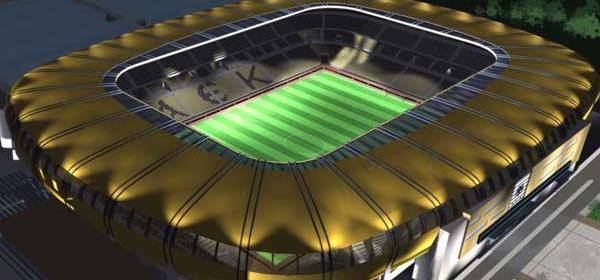
This is part three in a series where we look back at past new stadium proposals that were never realised. You can find the other two instalments here and here, and we will use this one to look at the basket cases of stadiums proposals, i.e. the ones that have long been abandoned or are still muddling along.
Some of these projects got stuck in bureaucracy, others were too expensive to attract sufficient funding, and still others were always more of a publicity stunt of a vain chairman than a serious proposal.
While the fans of these clubs often feel like they are the only ones in the world not to have moved into a new stadium, it turns out that there is a huge pile of hoped for stadiums that were never realised, and we still have enough old renders lying around for a next instalment.
We begin with a proposal of SS Lazio for a new stadium that was dubbed Stadio delle Aquile, a term that still sends the occasional visitor from Google to our site.
Both Lazio and AS Roma have long been unhappy in the much too large and rather impersonal Stadio Olimpico, which is owned by Italian Olympic committee CONI, which in turn prohibits the clubs from properly exploiting the stadium.
Right now it is Roma that is closest to building a new stadium, but in the mid 2000s it was Lazio that was presenting plans. The new stadium was to have a capacity of 40,000 seats, a transparent roof made up of solar panels, and was to be built at a location on the outskirts of Rome.
However, in the late 2000s the project lost traction because of bureaucratic difficulties and the financial crisis, and the stream of announcements on the progress slowly dried up. In the last year, Lazio have once more picked up the plan to move to a new stadium, but so much time has passed that it basically means starting from scratch again, which is a shame as the drawings that were published show quite an original and characteristic stadium.
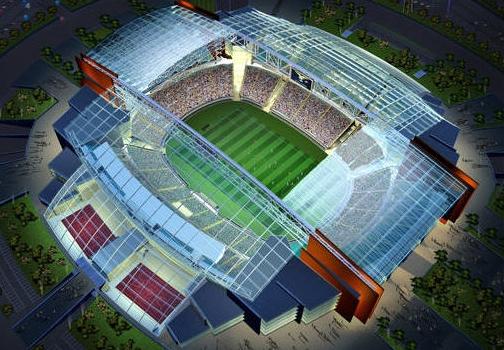
Real Zaragoza is one of those clubs that keeps revealing plans for a new or redeveloped stadium, but nothing ever comes of it. We had the choice between about five different designs that at one time were presented, and the one below is what they were working on in the mid 2000s.
This new stadium, which would replace Estadio La Romareda, would have a capacity of 42,500 seats, and was at one point scheduled to be completed in late 2007. While new stadium projects rarely go smoothly in Spain, the financial crisis made realisation all but impossible.
Occasionally, another news item pops up that suggests that some people in Zaragoza are still hoping to build a new stadium, but don’t count on it in the next decade.
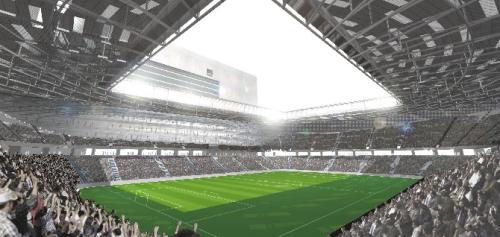
Then there is, of course, Everton, who first presented plans for a new stadium around the turn of the millennium.
These plans were ambitious, and aimed for a 55,000-all seater multi-purpose arena with a retractable roof and pitch. The stadium was going to be part of the King’s Dock waterfront redevelopment that would regenerate the area into an entertainment complex.
Fans voted strongly in favour of the project and it received backing of the Liverpool council, but in the end the club could not get the financing arranged and the project slowly died.
Later, Everton would move their focus on an out-of-town site near the town of Kirkby, but these also led to nothing and the club now seems set to stay at Goodison Park.
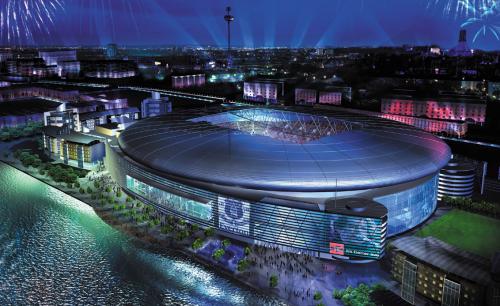
We move to the other end of the world for another hopeless case, which is Estudiantes de la Plata from La Plata in Argentina.
We remember being very impressed when we first saw the renders of their new stadium project. The almost vertical stand with private boxes a La Bombanera, the vast terraces behind the goal, and the transparent roof that covered the stands.
The new stadium with a capacity of 42,000 places was to replace Estudiantes’ old Estadio Jorge Luis Hirschi, though legal challenges resulted in continuing delays. Soon after, the old stadium failed to meet safety requirements, but fortunately Estudiantes had an alternative in the newly opened Estadio Ciudad de la Plata.
Estudiantes have remained with the ambition to build the stadium and in 2011 a legal opening was creating. Plans have been scaled down significantly though. The club recently published some photos of workers on the site and they hope to have the stadium finished in 2014, though fans are likely not holding their breath.
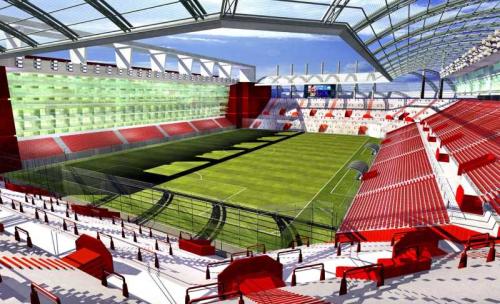
AEK’s story is very similar to that of Estudiantes. Their former home, Nikos Goumas Stadium, failed to meet safety standards, the club found a new home in the OAKA Olympic Stadium, and they demolished their old stadium and made plans for a new one.
The plans involved a new modern and covered stadium with a capacity of just under 40,000, but the stadium never came as a result of objections of local residents and a lack of financing.
The project was never officially abandoned and tentative plans for a new stadium may still exist, but nobody expects these to get realised in the next decade.
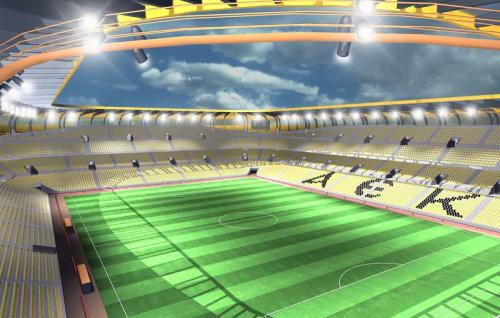
The United States have been much more prolific than Greece in terms of new stadium construction, but one club has been the exception: DC United. The club from the capital has long tried to replace the derelict and cold RFK Stadium for a smaller soccer-specific stadium, but to no avail.
DC United are still hoping to build a new stadium, though the desired location has since changed from Poplar Point to nearby Buzzard Point and it is likely that a future stadium will be somewhat less ambitious than previous plans.
While the club has not released any new drawings in recent years, one expects that the capacity of a new stadium will be lower than the 27,000 seats that were earlier proposed.
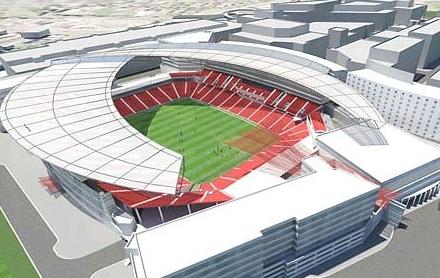
Then there is this project of Real Sociedad from the mid 2000s, dubbed Gipuzkoarena. While Real Sociedad’s Estadio Anoeta had only opened ten years earlier in 1993, the club and fans had never been happy in their new home that lacked atmosphere with the stands far from the pitch.
Then club-president José Luis Astiazarán therefore presented plans to completely redevelop the stadium, which included removing the athletics track, increasing capacity to 42,400 seats, and adding a hotel and retail to the complex.
The plans never really came off the ground and were soon rejected by the local council.
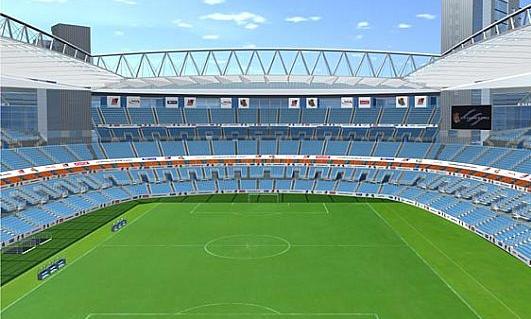
Finally, there is this project from Croatia, which may just be the most spectacular one of the lot. In the late 2000s, the city of Zagreb put out a contest for the design of a new stadium for the city, which would also become the new home of Dinamo.
One design stood out, which is the one below in the shape of a volcano. The stadium would have a capacity of 55,000 seats, and to top it off have a cloud-like structure suspended above the pitch to provide additional cover.
Architect Njirić won the contest, but funding soon turned out to be a major problem. The project got indefinitely delayed and finally officially cancelled a few weeks ago. In the meantime, focus had shifted to further redeveloping Stadion Maksimir, but works are not expected to start any time soon.
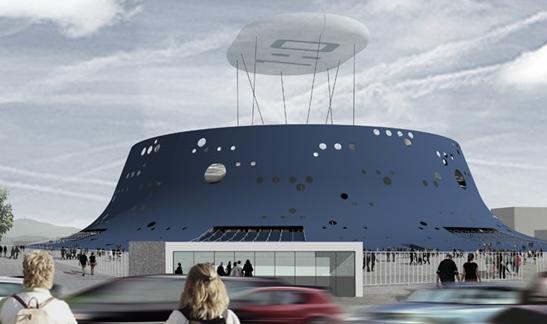
As we mentioned before, we still have quite a few renders of other proposals lying around, and will therefore soon publish a fourth instalment in this series.